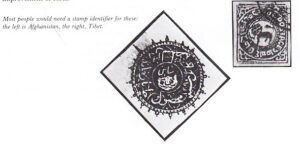The subject of mounting stamps has caused considerable disagreement within philatelic circles during the last decade. In the very early years of collecting, collectors just glued or pasted their stamps into their albums, or if the stamp was mint, they just licked it onto the album sheet as if it were a letter. After all, few early collectors believed their stamps would have any resale value, and accordingly they assumed that they would never need to be taken out of the album. Later, collectors began to use gummed tabs to mount their stamps, which did not come off unless the stamp was soaked. Still, the tab could be cut, and trading a stamp from an album did not mean tearing off part of the page, so this was an improvement of sorts.

The major invention in stamp collecting was the peelable hinge, which began to be popular just before 1920. The hinge is a small bit of glassine, a nonporous paper, lightly gummed on one side. The hinge is folded, so that part fastens to the stamp and part to the album page. With this invention, stamps for the first time could go in and out of collections easily. Hinges are so lightly gummed that they are quite simple to remove. But never take a hinge off a stamp until the hinge is thoroughly dry. All too often collectors will get a new stamp, hinge it into their album, then decide to remove it and hinge it again. By taking a wet or damp hinge off a stamp, you run a grave risk of thinning the stamp. A good rule is to wait three hours after affixing a hinge before trying to remove it. And do not overmoisten the hinge; a little moisture is all that is required. You stamps aren’t going anywhere.
Another development in stamp mounting that began to be popular in about 1950 was the plastic stamp mount, which offered stamps more protection than conventional hinges. A plastic mount is a very thin polyurethane sheet, closed on one, two, three, or ever four sides, in which the stamp is placed and then glued to the page. To retrieve the stamp, the mount is opened. A mount’s main advantage is that it allows the stamp to be mounted in an album without disturbing the gum in any way. This is quite the fashion in philately now, so it is recommended that you keep your mint stamps of philatelic value in mounts. However, when beginning a general collection, mounts are not recommended. They are expensive (averaging several cents apiece versus less than one-tenth of a cent, for a hinge) and they are time-consuming to use.
The dangers of stamp mounts should be mentioned here. Never use any form of cellophane, masking, or adhesive tape with a mount. All mounts are sold pre-glued, but if this glue should prove insufficient (people for whom this is true are called “heavy-tongued” in philatelic circles), use only glue that is specially prepared for stamp mounts and is sold in stamp stores. The mounts look impenetrable, but they are not. The plastic in the mount is thin, and many petroleum-based adhesives can soak right through it, damaging the stamp beyond recognition. Some mounts are open on two or more sides and may show a tendency for stamps to slip out the sides. If you buy this type of mount, but sure you can live with the problem. Some years ago, numerous collectors taped up the open ends of their mounts with Scotch tape. Their stamps are now worthless as they were stained severely by the tape. The worst you can do with a hinge is to thin a stamp, whereas a mount can ruin one.
Be careful when placing your stamps in the mount. Remember to make sure that all the corners are in before you close the mount. A small corner bend on an expensive stamp can cost you a lot of money. All in all, though, mounts are generally quite safe, and with a little practice and attention you will learn to use them correctly.
